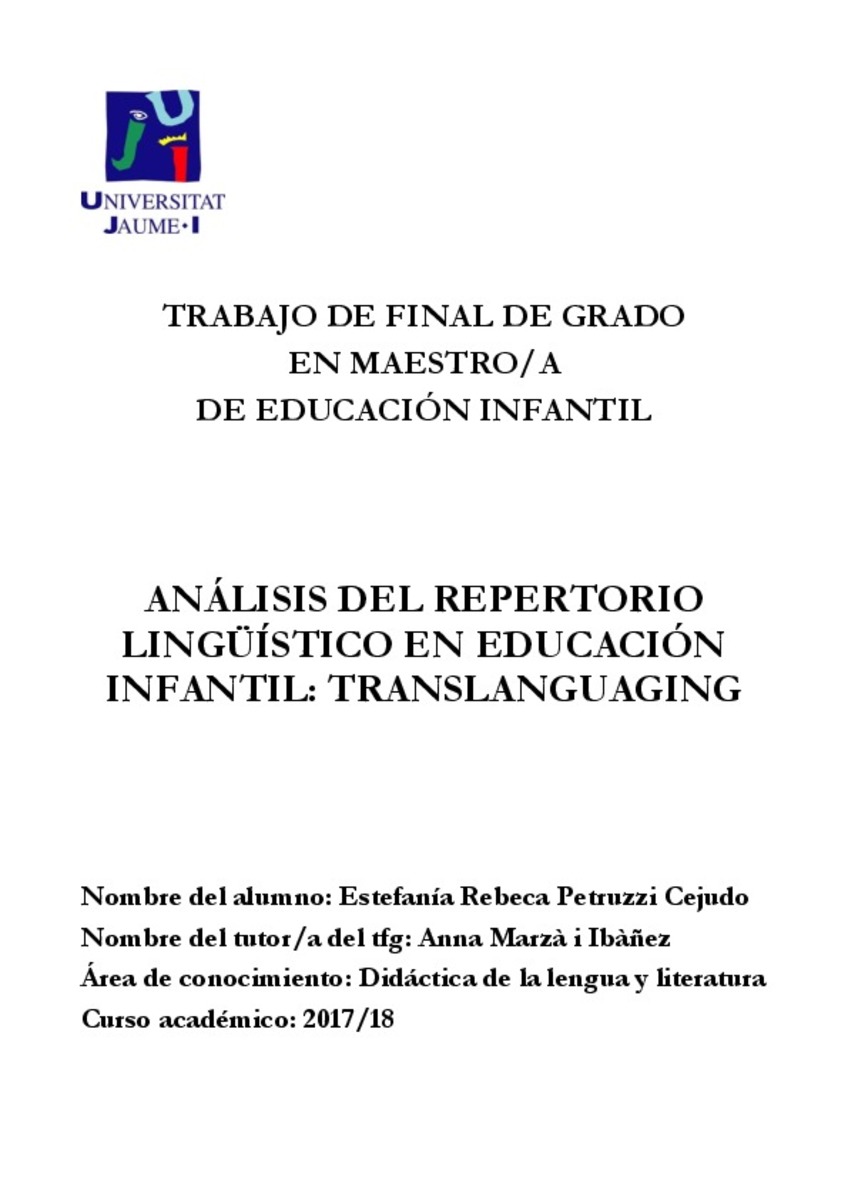Mostrar el registro sencillo del ítem
Análisis del repertorio lingüístico en Educación Infantil: translanguaging
| dc.contributor.author | Petruzzi Cejudo, Estefanía Rebeca | |
| dc.contributor.other | Marzá Ibáñez, Anna | |
| dc.contributor.other | Universitat Jaume I. Departament de Pedagogia i Didàctica de les Ciències Socials, la Llengua i la Literatura | |
| dc.date.accessioned | 2018-12-20T12:17:21Z | |
| dc.date.available | 2018-12-20T12:17:21Z | |
| dc.date.issued | 2018 | |
| dc.identifier.uri | http://hdl.handle.net/10234/178317 | |
| dc.description.abstract | El estudio muestra el análisis del repertorio lingüístico de un grupo de cuatro alumnos de infantil dentro de un contexto escolar plurilingüe en el cual se habla valenciano, castellano e inglés. Dicho análisis se centra en las manifestaciones de translanguaging de los alumnos. Método: Se sigue una metodología cualitativa basada en la observación participante de situaciones de aula para interpretar su significado posteriormente, además de una triangulación metodológica con notas de campo, una entrevista y transcripciones. Resultados: Se observa en los participantes claros ejemplos de translanguaging para excluir e incluir en las conversaciones y para mediar en la comprensión de otros compañeros. Conclusiones: El repertorio lingüístico de un niño, pese a su corta edad, está directamente influenciado por la escuela, su entorno familiar y/o su entorno más cercano. | ca_CA |
| dc.description.abstract | The study shows the analysis of the linguistic repertoire of a group of four students of children within a plurilingual school context in wich Valencian, Spanich and English are spoken. This analysis focuses on the uses of linguistic repe repertoire and translanguaging. Method: It follows a qualitative methodology based on the participant observation of classroom situations to interpret its meaning, as well a methodological triangulation with field notes, an interview and transcripts. Results: Clear examples of translanguaging are observed in the group to exclude and include in conversations and to mediate in the comprehension of other classmates. Conclusions: The linguistic repertoire of a child, despite his young age, is directly influenced by the school, the family environment and/or the inmediate environment. | ca_CA |
| dc.format.extent | 66 p. | ca_CA |
| dc.format.mimetype | application/pdf | ca_CA |
| dc.language.iso | spa | ca_CA |
| dc.publisher | Universitat Jaume I | ca_CA |
| dc.rights | Licencia CC-BY-NC-SA | ca_CA |
| dc.rights | Atribución-NoComercial-CompartirIgual 4.0 Internacional | * |
| dc.rights.uri | http://creativecommons.org/licenses/by-nc-sa/4.0/ | * |
| dc.subject | Grau en Mestre o Mestra d'Educació Infantil | ca_CA |
| dc.subject | Grado en Maestro o Maestra de Educación Infantil | ca_CA |
| dc.subject | Bachelor's Degree in Preschool Education | ca_CA |
| dc.subject | Repertorio lingüístico | ca_CA |
| dc.subject | translanguaging | ca_CA |
| dc.subject | multilingüismo | ca_CA |
| dc.subject | lengua materna | ca_CA |
| dc.subject | Linguistic repertoire | ca_CA |
| dc.subject | multilingualism | ca_CA |
| dc.subject | mother tongue | ca_CA |
| dc.title | Análisis del repertorio lingüístico en Educación Infantil: translanguaging | ca_CA |
| dc.type | info:eu-repo/semantics/bachelorThesis | ca_CA |
| dc.educationLevel | Estudios de Grado | ca_CA |
| dc.rights.accessRights | info:eu-repo/semantics/openAccess | ca_CA |
Ficheros en el ítem
Este ítem aparece en la(s) siguiente(s) colección(ones)
-
Grau en Mestre o Mestra d'Educació Infantil [1149]
MI1040; MI1840








